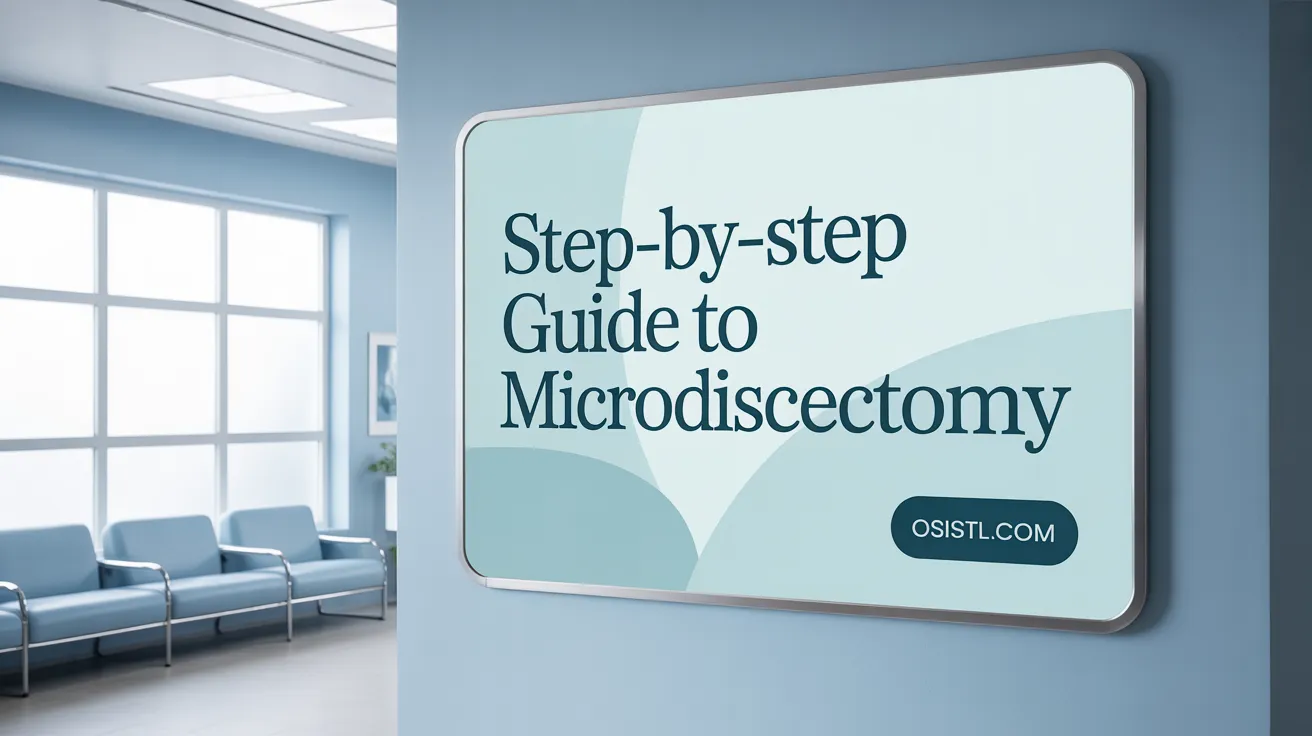Introduction to Microdiscectomy and Its Purpose
Microdiscectomy is a specialized minimally invasive surgical technique aimed at alleviating nerve compression caused by herniated lumbar discs. It has become the preferred surgical option when conservative treatments fail, offering patients significant pain relief, improved mobility, and faster recovery. This article unpacks the fundamentals of microdiscectomy, including indications, surgical steps, risks, outcomes, recovery, and anatomical insights to provide readers with a clear understanding of this common yet intricate procedure.
What Is Microdiscectomy and When Is It Recommended?

What is microdiscectomy and when is it recommended?
Microdiscectomy is a minimally invasive surgical procedure designed to relieve pressure on a nerve root caused by a herniated disc in the spine. This technique involves making a small incision, often about one to two inches, and using magnification with a microscope to precisely remove the herniated disc material pressing on the nerve.
This approach provides several advantages over traditional open surgery, including less trauma to surrounding tissues, quicker recovery times, and often reduced postoperative pain.
Indications for microdiscectomy typically arise when conservative nonsurgical treatments fail to alleviate symptoms after 6 to 8 weeks. Patients suffering from persistent pain, numbness, tingling, weakness, or neurological deficits due to herniated discs—most commonly in the lower back at levels L4–L5 or L5–S1—may be candidates.
The surgery is especially recommended in cases involving significant nerve compression signs, such as leg pain (sciatica), and when symptoms interfere with daily activities or quality of life (Sciatica surgical treatment).
In emergency situations, such as cauda equina syndrome—where there is loss of bowel or bladder control, severe leg weakness, or sensory loss—immediate surgical intervention with microdiscectomy is often necessary.
Overall, microdiscectomy offers a high success rate in symptom relief, quick recovery, and a lower complication profile, making it the preferred surgical option for many herniated disc cases (Benefits of lumbar microdiscectomy).
This procedure is performed under local or general anesthesia, depending on the extent of the case, and typically lasts about 1 to 2 hours (Lumbar microdiscectomy surgery procedure details). Postoperative care includes activity restrictions for a few weeks and physical therapy to restore strength and flexibility (Postoperative care after microdiscectomy).
Patients should discuss with their healthcare provider whether microdiscectomy is suitable for their specific condition, especially if conservative methods have not yielded adequate improvement (Deciding on disc surgery guide).
Detailed Surgical Steps of Microdiscectomy

Use of Small Incision and Minimal Tissue Disruption
microdiscectomy is performed through a small incision, usually about 1 to 2 inches long, in the lower back. This minimally invasive lumbar discectomy approach causes less trauma to surrounding muscles and tissues. The goal is to reduce postoperative pain, shorten recovery time, and limit the risk of complications.
Operative Microscope and Magnification
A specialized operating microscope is employed to provide magnified, well-illuminated views of the surgical site. This enhanced visualization allows the surgeon to precisely identify and remove herniated disc material while preserving nearby structures.
Localization of Affected Disc Space via Imaging
Preoperative imaging such as MRI or intraoperative fluoroscopy helps accurately locate the affected disc level. This step is crucial to ensure the correct disc is targeted and to avoid unnecessary exposure to surrounding tissues.
Muscle Retraction and Preservation
The surgeon gently retracts the back muscles to access the lamina and disc space. Thanks to the small incision and advanced techniques, muscle tissue experiences minimal disruption, promoting a quicker and less painful recovery (microdiscectomy advantages).
Lamina and Ligamentum Flavum Handling
A small segment of the lamina may be removed (laminotomy) to reach the herniated disc. The ligamentum flavum, a ligament that covers the spinal canal, is incised carefully under magnification to expose the dura and nerve roots (microdiscectomy procedure steps).
Removal of Herniated Disc Material
The herniated portion of the disc pressing on the nerve root is gently excised using microsurgical instruments. The surgeon ensures that all problematic tissue is removed to decompress the nerve, alleviating symptoms such as pain, numbness, or weakness.
Variations in Approach Based on Herniation Location
Depending on where the herniation occurs—central, foraminal, or extraforaminal—different surgical options may be used. Approaches like far-lateral or micro-endoscopic discectomy are tailored to optimize access while minimizing tissue damage.
This stepwise process ensures effective removal of the herniated disc with minimal impact on the patient's back, leading to faster recovery and high rates of symptom relief (clinical outcomes of microdiscectomy).
Risks and Benefits of Microdiscectomy Surgery

What are the risks and benefits associated with microdiscectomy surgery?
Microdiscectomy is widely regarded as a highly effective and minimally invasive surgical option for treating herniated lumbar discs. Patients often experience significant pain relief, especially in leg pain caused by nerve compression, with many reporting immediate or gradual improvement within days to weeks after the procedure (Microdiscectomy surgery overview).
One of its greatest advantages is the shorter recovery period. Because it involves a smaller incision and causes less trauma in surrounding muscles and tissues, patients typically have shorter hospital stays and can return to normal activities more quickly than with traditional open discectomy (Minimally invasive lumbar discectomy).
Furthermore, the procedure enhances visualization of the affected nerve and disc herniation, allowing precise removal of herniated tissue while minimizing collateral tissue damage. This results in less postoperative pain, reduced blood loss, and a lower risk of complications such as epidural fibrosis (Advantages of microdiscectomy).
However, like all surgeries, microdiscectomy carries certain risks. The most common potential complications include dural tears, which can cause cerebrospinal fluid leaks, nerve root injury leading to neurological deficits, infections, bleeding, or recurrent disc herniation. Although these complications are relatively rare, they necessitate careful surgical technique and postoperative management (Complications of microdiscectomy).
The overall safety profile of microdiscectomy is favorable. Numerous studies and systematic reviews have demonstrated high success rates—approximately 80-90%—and high patient satisfaction, with most patients experiencing marked relief of symptoms and an improved quality of life (Microdiscectomy success rates).
In conclusion, when performed on properly selected candidates by experienced surgeons, microdiscectomy offers substantial benefits with a relatively low complication rate, making it a preferred surgical choice for many patients with herniated lumbar discs (Lumbar Microdiscectomy procedure).
Expected Outcomes and Success Rates After Microdiscectomy

What are the expected outcomes and success rates following microdiscectomy?
Most patients who undergo microdiscectomy experience substantial relief from leg pain, numbness, and weakness caused by nerve compression due to herniated discs. Immediately or within days to weeks after surgery, many report improvement in symptoms, with pain relief rates typically falling between 80% to 90%. Additionally, a high percentage of patients regain mobility and return to daily activities.
Long-term results show that the positive effects of microdiscectomy are often sustained over time. Studies tracking up to 10 years after surgery indicate that approximately 83% of patients maintain their initial improvements. Satisfaction levels are similarly high; around 76-77% of patients report being pleased with their surgical outcome.
Factors influencing success include timely surgery, proper patient selection, and adherence to postoperative instructions like physical therapy. The recurrence rate of herniation, which can necessitate reoperation, ranges from 10% to 25%, mostly occurring within the first year.
When comparing microdiscectomy to other surgical options, it generally results in shorter hospital stays, fewer complications, and comparable or better long-term outcomes. Its minimally invasive nature also promotes quicker recovery and less postoperative discomfort.
For patients seeking detailed statistics or considering surgery, searching for 'microdiscectomy success rates and outcomes' can provide additional in-depth information.
Postoperative Recovery Process: Timelines, Care, and Rehabilitation
 Recovery after a microdiscectomy involves several stages, extending from initial healing to full functional recovery. Generally, most patients experience significant pain relief and minimal discomfort within the first few days, with initial healing of the surgical site typically occurring over 1 to 2 weeks. During this period, managing pain and reducing inflammation through prescribed medications and ice packs is essential.
Recovery after a microdiscectomy involves several stages, extending from initial healing to full functional recovery. Generally, most patients experience significant pain relief and minimal discomfort within the first few days, with initial healing of the surgical site typically occurring over 1 to 2 weeks. During this period, managing pain and reducing inflammation through prescribed medications and ice packs is essential.
As healing progresses, patients are encouraged to begin gentle activities such as walking, usually starting within the first day post-surgery. Short, frequent walks help promote circulation, decrease stiffness, and support tissue healing. Activity restrictions include avoiding heavy lifting, twisting, or strenuous exercise for at least 4 to 6 weeks, depending on individual progress.
Gradual resumption of daily activities and work is common around 2 to 3 weeks, especially for desk jobs. Full recovery, including returning to vigorous activities or sports, typically occurs within 3 to 6 months. Adherence to activity restrictions and a structured rehabilitation program are key to optimal outcomes.
Physical therapy plays a vital role in recovery, focusing on strengthening core muscles, improving mobility, and preventing future back problems. It usually begins around 4 to 6 weeks after surgery and can speed up return to normal function.
Patients should watch for signs of complications, such as increasing pain, redness or swelling at the incision site, fever, numbness, or weakness. Monitoring postoperative symptoms closely and attending scheduled follow-up visits ensure proper healing.
Home care tips include keeping the incision clean and dry, following medication instructions carefully, and avoiding activities like bending forward excessively or lifting heavy objects. Maintaining a healthy weight and engaging in low-impact exercises like swimming or cycling after initial healing can also support long-term spinal health.
In summary, the postoperative recovery process involves managing discomfort, gradually increasing activity, and participating in physical therapy. Following your surgeon’s specific instructions can help ensure a smooth recovery, with most patients returning to their normal routines within 4 to 6 weeks and achieving full recovery in about 3 months.
Factors Affecting Recovery, Long-Term Results, and Anatomical Considerations
Which factors can affect recovery and long-term results after microdiscectomy?
Recovery after microdiscectomy is influenced by multiple patient-specific and surgical factors. Age plays a significant role, as younger patients tend to heal faster and have better outcomes. Overall health, including comorbid conditions such as diabetes or obesity, can delay healing and increase complication risks.
The severity and location of the disc herniation also impact recovery. Larger or more complex herniations, especially those affecting multiple nerve roots or located at difficult-to-access levels like L5–S1, may require longer recovery and sometimes additional interventions.
Adherence to postoperative rehabilitation protocols, including physical therapy, is crucial for optimal healing. Patients who follow activity restrictions and engage in prescribed exercises typically experience better long-term outcomes.
Lifestyle factors like smoking and obesity have been shown to negatively influence healing. Smoking impairs blood flow and tissue repair, reducing the effectiveness of the surgery.
Other spinal conditions, such as degenerative disc disease or spinal instability, may complicate recovery and require additional treatments. For more on risks and complications, see Microdiscectomy complications.
How does microdiscectomy compare with other surgical options for treating herniated discs?
Microdiscectomy is widely regarded as the preferred minimally invasive approach for isolated lumbar disc herniation. It offers advantages such as smaller incisions, less muscle trauma, shorter hospital stays, and quicker recovery.
Compared to traditional open discectomy, microdiscectomy results in similar or better long-term relief of radiculopathy with fewer complications. In cases where spinal instability or extensive degeneration exists, procedures like spinal fusion or disc replacement may be indicated instead. See more at Lumbar discectomy surgery.
Studies have shown that the success rate of microdiscectomy, with symptom relief around 80–90%, surpasses conservative treatments and is comparable to other surgical methods for suitable candidates, as detailed in Microdiscectomy success rates.
What are the key medical terms and anatomical structures involved in microdiscectomy?
Understanding the anatomy involved in microdiscectomy is essential for its success. Key terms include:
- Intervertebral disc: The shock-absorbing structure between vertebrae.
- Herniated disc: When the nucleus pulposus protrudes through the annulus fibrosus, pressing on nearby nerves.
- Nerve root: The nerves exiting the spinal cord; in the lumbar spine, they exit through foramina.
- Lumbar levels: Commonly affected sites are L4–L5 and L5–S1.
- Lamina: The part of the vertebral arch removed or drilled during surgery to access the disc.
- Ligamentum flavum: A ligament that is incised to reach the epidural space and herniated disc. Critical for access, it is carefully incised to avoid nerve injury.
The procedure involves precise identification of these structures, resection of the lamina and ligamentum flavum as needed, mobilization of nerve roots, and careful removal of herniated disc material.
Anatomical landmarks such as spinous processes and sacral crests help guide the approach, while distinguishing between traversing and exiting nerve roots prevents nerve damage. This detailed knowledge ensures effective decompression while minimizing risks. For detailed anatomy and surgical procedure, see Microdiscectomy surgical steps and Lumbar Microdiscectomy procedure.
Conclusion: The Role of Microdiscectomy in Treating Herniated Discs
Microdiscectomy stands as a highly effective and minimally invasive surgical option for patients suffering from symptomatic lumbar disc herniations unresponsive to conservative management. By utilizing small incisions and advanced visualization techniques, this procedure minimizes tissue damage, reduces complications, and accelerates recovery. Understanding the surgical steps, risks, and recovery protocols empowers patients to make informed decisions and actively participate in their healing process. With success rates often exceeding 80%, microdiscectomy offers renewed relief and improved quality of life, reinforcing its role as a gold standard in spine surgery for targeted nerve decompression.
